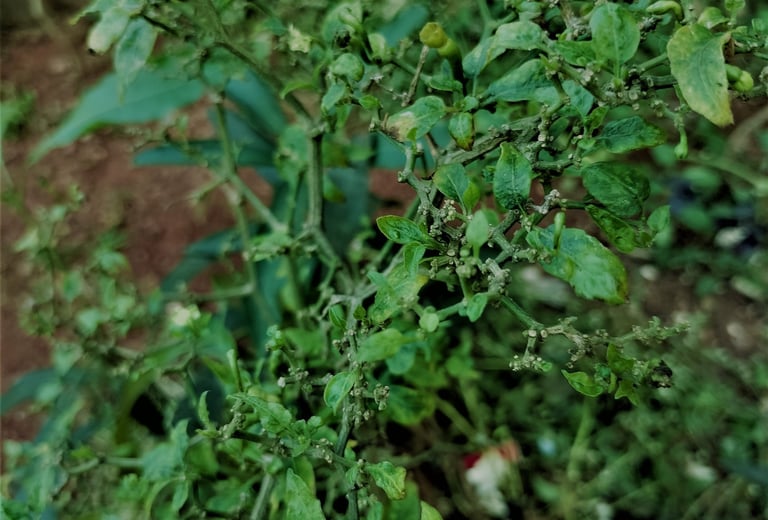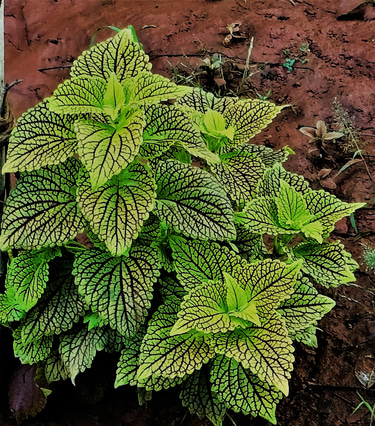Four Important Diseases of Chilli Crop
Chilli is an important ingredient of Asian and Mexican Cuisine and cultivated in tropical and subtropical regions. Its production is affected with the occurrence various diseases and have the potential to reduce the yield loss to the great extent if managed well.
Satish Naik
6/15/20235 min read


Chilli is an important ingredient of Asian and Mexican Cuisine, known for its hot and spicy flavor, because of the presence of capsaicin. Chillis are used in the form of raw or ripened or dried fruits and also in the form of powder, flakes and sauce. India ranks first in production of chilli in the world, followed by Thailand and China. As a crop, chilli plants flourish well in tropical and subtropical regions. But susceptible to many diseases like damping off, fruit rot, different kind of leaf spots, mosaic, powdery mildew etc. Early detection and proper management are very important to have good yield.
Important Diseases of Chilli Crop
Damping of chilli is mainly a nursery disease, though some time affects at field after transplanting. It is a fungal disease caused by Phythium aphanidermatum. It is a major disease of chilli which causes the higher economic loss by following ways
Poor Germination of seeds: Phythium aphanidermatum is a soil borne fungus, can interfere with the process of seed sprouting leading to poor germination.
Pre emergence die back of seedling: Here seedlings are died before they emerge from soil surface.
Post Emergence damping off : In this case seedlings emerges out of soil surface, but fail to establish later on. This is associated poor root development and weak stem. In advanced stages plant shows rotting of stem at the which it touches soil, leading to dislodging of plants. In some occasion they extend to main field causes damage even after transplanting.
The disease is symptomatic of Water Soaked lesion in collar region, shriveled and wiry stem, poor root development. Here seedlings fail to establish and collapse and die. Rotting of stem disturbs the translocation of water and nutrients and affects the plant metabolism.
Heavy rain fall followed by high temperature favors the fungi multiplication. In case of poorly drained soil and excess irrigation, fungal infection becomes more threatening and very difficult to control.
Damping Off or Collar Rot:
Management of damping off of chilli
1. Selection of field free from history of soil born fungus: Oospores are the sexual spores from which fungus multiply in case of Pythium aphanidermatum and same is characterized by thick cell wall. These oospores can survive adverse condition and even in absence of host. Thus any location with previous incidence of soil borne fungi to be avoided for chilly cultivation, especially raising of the nursery.
2. Collection and destruction of affected plants: Infected plants are to be collected and destroyed to avoid further spread of inoculum. Trashes of plants after harvest may be collected and burnt from infected field.
3. Seed Treatment: Treating of seeds for 24 hours before sowing with Trichoderma asperellum @ 4g/kg or Pseudomonas fluorescens @ 10g/kg.
4. Chemical Treatment: Drenching the soil around the plant with copper oxychloride @ 2.5g/l . Application of Pseudomonas flurescence @ 2.5kg/50kg of FYM /ha.
Anthracnose of Chilli
Anthracnose disease in chilli is caused by Colletotrichum fungi like Colletotrichum trucatum, Colletotrochum acutatum and Colletotrichum gleosporoides. This symptoms otherwise called fruit rot of chilli. Formation of black sunken lesions and necrotic tissues with concentric rings of acervuli. Acervulus is a asexual fruiting body developed by host plants on fungal infection which acts as a cushion on which conidiophores are formed. In some cases plant shows lesions on leaves and stem also. This is a seed borne disease.
As chilli is tropical and subtropical crop where hot and humid climate prevails, same favors the development of fungus. Intensive rain fall followed by increased temperature up to 30 degree centigrade and 80% relative humidity, often congenial to development of Anthracnose fungi. These fungi can even cause damage to chilli in post harvest stage which reduces the merchantability.
Management of Antracnose disease in chilli
Cultural control :
Use of disease free seed.
Removal of weeds in the field to destroy alternate hosts to fungus
Early planting and choosing of short duration variety, so that crop can complete its life cycle before establishment of disease.
Deep post harvest plouging and collection of plant debris and destruction of the same.
Providing proper drainage to field so that excess soil moisture and moistening of surrounding is avoided to control incidence of disease.
Crop rotation is recommended if field that experience incidence of anthracnose disease.
Biological control Antracnose disease in chilli
Use of Trichoderma which competes for surface area with disease causing fungi and puts check on their growth.
Bacillus subtilis and Candida olephila are two yeasts found effective in control of Anthracnose.
Use of plant Extract
Use of plant extracts like Azadirachta @10% or Allium sativum @10% have been reported useful in management of anthracnose of chilli
Chemical control:
Seed treatment with Captan @3 g/kg or Trichoderma @4 g/kg or Pseudomonas florescence @ 10 g/kg of seed are recommended.
Taking up of 3 sprays at the fortnightly intervals, starting just before flower initiation has been found effective. Fungicide recommended to spray is Captan 0.2%.
Chilli Leaf Curl Disease:
Chilli leaf curl disease is caused by virus of genus Begomovirus, belonging to family Geminiviridae. This virus is vectored by white flies, insects of order Hemiptera. This virus is with limited host range like Tomato, Potato and Amaranthus.
The disease is characterized by upward curling of leaves, reduction in leaf area, shrunken and folded leaves, shortened leaf petiole, short inter nodes, bunchy appearance and stunted plant growth in total. Affected plant bears less flowers and small sized deformed fruits. Condition becomes worst if viral infection associated with infestation of different sap sucking insects like thrips and aphids.
The conditions like continuous rainfall followed by sudden rise in temperature, increased relative humidity, presence of alternate hosts favors the activities of vectors.
Control measures of chilli leaf curl disease:
Collection and destruction of affected plants.
. Use of yellow colored sticky traps to control white flies.
Use of natural predator of white flies, like lady bird beetles, Green lace wing, minute pirate bugs, etc
Use of entomo-pathogenic fungi like Beauveria bassiana and Isaria fumosorosea as bio pesticides which causes muscardine disease in insects like white flies, thrips and aphids, to kill them.
Cultivation of plants like marigold as inter crops or in surrounding area to repels the white flies.
Cercospora leaf spot of Chilli plant
Cercospora leaf spot is fungal disease of Chilii. This is caused by fungus Cercospora capsici. The disease is symptomatic of circular lesion on leaf with light gray center and with brownish margin. This symptoms is otherwise called 'frog eye spot'. The lesion may spread and coalesce in later stage and gray centers dry and tear off. In advance stage they spread to leaf petiole, stem and fruits. Affected leaves and fruit may fall off prematurely.
Management of Cercospora leaf spot of Chilli
Seed treatment with suitable fungicide
Crop rotation to break the chain of existence of pathogen.
Collection and removal of plant debris after harvest to destroy fungal inoculum.
Two sprays of Mancozeb at the interval of 15 days @0.25%.
Ensuring of proper drainage to keep the filed dry to prevent development and spread of pathogens.
Newsletter
Sign up for our newsletter and get notified about all new posted articles.
ADDRESS
House No. 2-113(P), Visnumurthynagar, Kelarkalabettu, Thenkanidiyuru, Udupi
cONTACT
7975809540
satishmqc362@gmail.com
